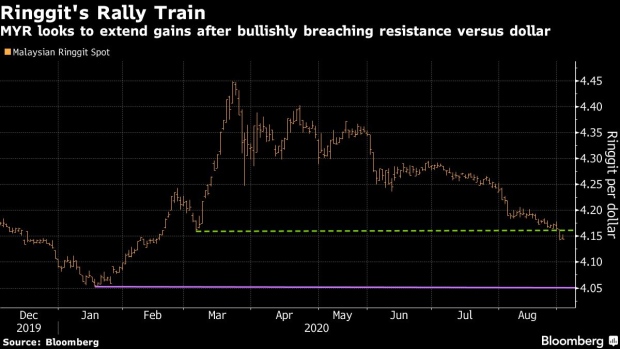Sep 6, 2020
Malaysia’s Currency Faces Two Key Risks After Beating Asia Peers
, Bloomberg News

(Bloomberg) -- The Malaysian ringgit has defied the odds to outperform most of its Asian peers. Now investors will be watching to see if it survives the trials of September.
A three-month rally in the currency could come to a halt when FTSE Russell announces a decision on whether it’ll retain ringgit bonds in its World Government Bond Index. A lesser risk is also brewing in the form of an expected rate cut from Bank Negara Malaysia.
The ringgit’s surprising strength in the face of months of political turmoil has been a vote of confidence for Prime Minister Muhyiddin Yassin who is looking to revive spending to pull the economy out of its biggest slump since 1998. If Malaysian bonds are removed from FTSE’s index, debt inflows could dry up, depriving the currency of a key source of support.
Like most of its Asian peers, the ringgit has benefited from a weak dollar and robust demand for higher-yielding debt. It has gained more than 3% since the start of July to outperform all but one of its Asian peers.
The ringgit bullishly breached resistance at its March high against the greenback, and may head toward 4.05 before year-end. The currency traded at 4.1475 on Friday.
But what happens from here would depend much on FTSE’s decision which is due Sept. 24. Goldman Sachs Group Inc. said last year outflows could reach $6 billion should the nation be dropped.
“We continue to see a higher probability of status quo i.e. no change in classification and weights,” MUFG Bank Ltd. analysts led by Derek Halpenny wrote in a report last week, referring to the FTSE decision. “This means that foreign investors may continue to buy Malaysian sovereign bonds, particularly as real yields remain the highest in the region albeit at a declining trend.”
Investors will also be watching Bank Negara Malaysia’s policy meeting on Thursday, with four of 14 economists in a Bloomberg survey expecting a 25-basis point cut. The remaining 10 see no change.
At its last review on July 7, the central bank said it would “continue to utilize its policy levers as appropriate” to support growth, fueling speculation of more easing.
Below are the key Asian economic data and events due this week:
- Monday, Sept. 7: China trade balance, Indonesia foreign reserves
- Tuesday, Sept. 8: Australia business confidence, Japan labor cash earnings, BoP current account balance and 2Q GDP
- Wednesday, Sept. 9: Australia consumer confidence and home loans, New Zealand business confidence and 2Q manufacturing activity, China CPI and PPI, South Korea unemployment rate
- Thursday, Sept. 10: Bank Negara Malaysia rate decision; Australia consumer inflation expectations, New Zealand credit card spending, Japan core machine orders, Philippines trade balance
- Friday, Sept. 11: New Zealand manufacturing PMI, Japan PPI, Malaysia and India industrial production
©2020 Bloomberg L.P.